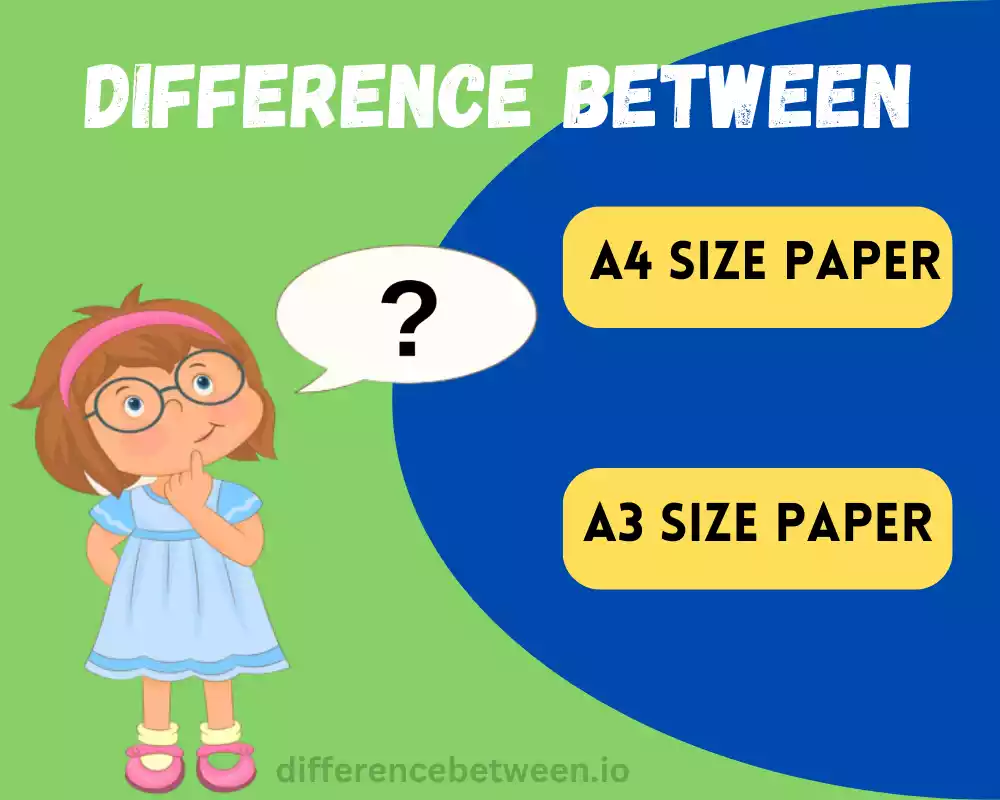A Definition of A4 and A3 Size Paper
A4 size paper:
A4 size paper is a standardized paper size defined by the ISO 216 international paper size standard. A4 paper size is part of A-series paper sizes; A0 being the largest and A10 the smallest. In many regions such as Europe and Asia A4 is by far the most commonly used size – used extensively for printing, writing, and other written material creation processes. A4 size paper provides a balanced aspect ratio and is compatible with most printers, copiers, and standard office equipment.

A3 size paper:
A3 size paper is a standardized paper size defined by the ISO 216 international paper size standard. A3 size measures 297 millimeters wide by 420 millimeters high; 11.69 inches by 16.54 inches respectively. A3 belongs to A-series sizes which start with A0 as the largest and A10 being its smallest member.A3 size paper is twice the size of A4 paper.
It is commonly used for larger documents, such as posters, presentations, architectural drawings, diagrams, and artwork that require more space. A3 paper provides a wider aspect ratio compared to A4, allowing for more content to be displayed or printed on a single sheet. Due to its larger size, A3 paper may require specific printers or copiers capable of handling this paper size.
Importance of understanding the differences between A4 and A3 size paper
Understanding the differences between A4 and A3 size paper is important for several reasons:
- Proper Document Formatting: A4 and A3 paper sizes have distinct dimensions, and using the wrong size can result in improperly formatted documents. Understanding the differences ensures that your documents are correctly aligned and proportioned, avoiding any cropping or distortion issues.
- Printing and Reproduction: Knowing the distinctions between A4 and A3 paper helps when printing or reproducing documents. It allows you to select the appropriate paper size settings on printers, copiers, and other printing devices, ensuring accurate output without unnecessary cropping or scaling.
- Design and Layout Considerations: A4 and A3 paper sizes affect the design and layout of various materials, such as brochures, posters, and presentations. Understanding the differences allows designers to optimize their designs to fit the available space and ensure the visual elements are appropriately scaled and balanced.
- Compatibility and Standardization: A4 size paper is widely used as the standard for many office documents, while A3 size paper is commonly used for larger materials. Knowing which size is suitable for different purposes ensures compatibility with existing standards, equipment, and filing systems.
- Cost and Resource Management: A3 size paper is larger and more expensive than A4 size paper. Understanding the differences helps in making informed decisions about paper usage, minimizing waste, and optimizing resource management. It allows you to select the most cost-effective option for specific printing or document requirements.
- Communication and Collaboration: Clear communication and collaboration often involve sharing documents and materials. Understanding the differences between A4 and A3 paper sizes enables effective communication when discussing document requirements, sharing drafts, or coordinating projects involving different-sized materials.
Understanding the distinctions between A4 and A3 size paper is crucial for proper document formatting, printing accuracy, design considerations, compatibility, cost management, and effective communication. It ensures that documents are correctly presented, optimized for their intended purpose, and aligned with industry standards and requirements.
What is A4 Size Paper?
A4 size paper is a widely used standard paper size defined by the ISO 216 international paper size standard. A4 paper sizes belong to A-series paper sizes, where A0 represents the largest paper size while A10 represents its smallest dimension. A0 represents paper dimensions which can reach A4, while A10 represents its smaller counterparts.

A4 paper is widely utilized across Europe, Asia and other areas. It has a balanced aspect ratio and provides a good compromise between readability and space utilization. A4 paper is often used for various purposes, such as printing documents, letters, reports, business correspondence, and academic papers. Office printers can be used for photocopying, faxing and scanning documents.
One of the reasons for the popularity of A4 size paper is its compatibility with standard office equipment, including printers, copiers, and filing systems. It is widely supported by software applications and is the default size in many word processing programs.
A4 size paper offers a sufficient amount of space for written content and allows for easy handling and storage. Its dimensions make it convenient for folding into thirds to fit into standard envelopes. A4 paper can be resized to other A-series sizes, such as A5, A6, or A3, by halving or doubling the dimensions while maintaining the same aspect ratio.
A4 size paper is a versatile and widely accepted paper size that is suitable for various applications and is the preferred choice for many day-to-day office and printing needs.
What is A3 Size Paper?
A3 size paper is a standard paper size defined by the ISO 216 international paper size standard. It measures 297 millimeters (mm) in width and 420 mm in height, which is equivalent to 11.69 inches by 16.54 inches. A3 size paper is twice the size of A4 paper.
A3 size paper is part of the A-series paper sizes, with A0 being the largest and A10 being the smallest. It is commonly used for larger documents, such as posters, presentations, architectural drawings, diagrams, and artwork that require more space. A3 paper provides a wider aspect ratio compared to A4, allowing for more content to be displayed or printed on a single sheet.
The larger dimensions of A3 paper make it suitable for projects that require more detail, visual impact, or a larger canvas. It offers more space for diagrams, illustrations, and graphical elements. A3 paper is often used in industries such as advertising, design, engineering, and architecture.
When printing on A3 size paper, it is important to note that standard printers and copiers typically handle A4 size paper by default. Specialized printers or devices capable of accommodating larger paper sizes are required for printing on A3 paper.
A3 size paper can also be used to print multiple A4 size pages on a single sheet, which is useful for creating booklets, brochures, or handouts.
It’s worth mentioning that A3 size paper is not as widely used as A4 size paper, as it is primarily employed for specific purposes that require larger format printing or visual impact. In environments where large documents or visual materials are common, A3 size paper is an important option to consider.
Differences Between A4 and A3 Size Paper

The differences between A4 and A3 size paper can be summarized in the following aspects:
- Size and Dimensions: A4 paper measures 297x297mm (8.27″ by 11.69″) while A3 paper has larger dimensions – measuring 297x420mm (16″x 16″.) A3 paper is exactly twice the size of A4 paper in both width and height.
- Aspect Ratio: A4 paper has an aspect ratio of 1:√2, which means that when you fold it in half along its shorter side, it retains the same proportions. A3 paper also maintains the same aspect ratio of 1:√2 when folded in half along its shorter side.
- Uses and Applications: A4 paper is commonly used for everyday office documents such as letters, reports, and forms. It is also suitable for printing documents, assignments, and other written materials. A3 paper, on the other hand, is often used for larger documents such as posters, presentations, architectural plans, engineering drawings, and artwork that require more space and visual impact.
- Printing Considerations: Most standard printers and copiers are designed to handle A4 size paper as their default size. A3 size paper requires specialized printers or devices capable of accommodating larger paper sizes. Printing on A3 paper may involve specific settings and adjustments to ensure proper alignment and scaling.
- Availability and Compatibility: A4 size paper is the most commonly used paper size worldwide, widely available, and compatible with most printers, copiers, and standard office equipment. A3 size paper, while less common, can be readily obtained from specialized stationery stores or ordered online. Compatibility with standard office equipment may vary, requiring specific devices that support A3 paper.
Understanding these differences between A4 and A3 size paper helps in selecting the appropriate paper size for specific needs. A4 is suitable for everyday office documents and general printing tasks, while A3 is more suitable for larger-format materials requiring more space and visual impact. It is important to consider the intended use, printing capabilities, and availability of the paper size when making a decision.
Similarities Between A4 and A3 Size Paper
While A4 and A3 size paper have several differences, they also share some similarities, including:
- Common ISO Paper Standards: Both A4 and A3 size papers are part of the ISO 216 international paper size standard. This standard ensures consistency and compatibility in paper dimensions across different countries and industries.
- Quality and Weight Considerations: A4 and A3 size papers are available in various quality grades, such as standard copy paper, inkjet paper, and premium paper. They can also be found in different weights, typically measured in grams per square meter (gsm). Common weights include 80 gsm, 90 gsm, and 100 gsm, among others. The quality and weight options are similar for both A4 and A3 size papers.
- Potential for Resizing: Both A4 and A3 size papers can be resized to other A-series paper sizes by halving or doubling the dimensions while maintaining the same aspect ratio. This resizing capability allows for flexibility when adjusting document layouts or printing multiple pages on a single sheet.
It’s important to note that while A4 and A3 size papers share these similarities, they still have distinct differences in terms of dimensions, uses, printing considerations, and availability. Understanding both the similarities and differences can help in choosing the most suitable paper size for specific applications and requirements.
Choosing Between A4 and A3 Size Paper
Choose your paper size based on the needs and specifications of your task or project. Consider these aspects when making this selection:
- Content and Space Requirements: Consider the amount of content you need to include in your document or the space you require for your design. A4 size paper is suitable for most standard office documents and regular printing needs. It provides ample space for written content and is commonly used for letters, reports, and assignments. A3 size paper offers more space for larger graphics, diagrams, and visual materials. It is ideal for posters, presentations, architectural plans, and other documents that require a larger canvas.
- Printing and Reproduction: Evaluate the printing capabilities and equipment available to you. A4 size paper is widely supported by standard printers, copiers, and office equipment. It can be easily printed using common devices found in most offices or homes. If you need to print on A3 size paper, you may require specialized printers or copiers capable of accommodating larger paper sizes. Consider the availability and compatibility of such equipment when choosing between A4 and A3.
- Cost Implications: Cost is another important factor to consider. A4 size paper is generally more cost-effective and widely available compared to A3 size paper. A3 paper is larger and, as a result, often more expensive. If your project does not require the additional space provided by A3, sticking with A4 can help reduce costs. If the larger format is necessary for your specific needs, the added cost may be justified.
- Practicality and Portability: Consider the practicality and portability of the final document. A4 size paper is more convenient for handling, filing, and storage due to its standard size. It fits easily into folders, envelopes, and standard office storage systems. A3 size paper, being larger, may be less portable and require specialized storage solutions. If you anticipate the need for frequent handling or transportation of the document, the practicality of using A4 paper may be preferable.
- Industry or Contextual Standards: Consider any industry-specific or contextual standards that may influence your decision. Certain industries or contexts may have specific requirements or conventions regarding paper sizes. For example, architectural firms may often use A3 size paper for their plans, while a marketing team may prefer A4 size for their promotional materials. Understanding the conventions and expectations within your field can help guide your decision.
The choice between A4 and A3 size paper depends on factors such as content requirements, printing capabilities, cost considerations, practicality, and industry standards. Assessing these factors will help you determine the most suitable paper size for your specific project or task.
Conclusion
Understanding the differences between A4 and A3 size papers is crucial for making informed decisions when printing or creating visual materials. A4 size paper is the standard for most everyday printing needs, offering cost-effectiveness and convenience. On the other hand, A3 size paper serves well in scenarios that demand larger visual representations and artistic endeavors.
Whether it’s for work, education, or creative pursuits, knowing the strengths of each paper size empowers individuals and businesses to choose the perfect fit for their unique requirements.

